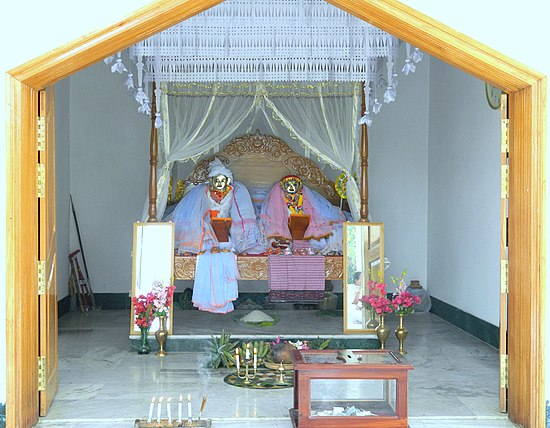Lairembi
Lairembi (/ˈlaɪræmbi/; Old Manipuri: Lailempi) or Lairemma (/ˈlaɪræmmə/; Old Manipuri: Lailemma), is the Meitei word for 'goddess' or 'female deity',[1][2] the male form is "Lairemba". It is a female term for a deity in Sanamahism (Meitei religion).[1][2][3]

The idea and reverence for the goddesses appears in the Puya (Meitei texts).
Examples[change | change source]
Imoinu[change | change source]
Imoinu is the Meitei goddess of wealth, prosperity, hearth fire and family. She lives either in the kitchen or the Sanamahi Kachin.[4][5]
Leimarel Sidabi[change | change source]
Leimarel Sidabi is the highest female divinity in Meitei religion. She is the highest mother earth goddess as well as the wife of Atingkok, the supreme creator god.[6][7][8]
Nongthang Leima[change | change source]
Nongthang Leima (Meitei: ꯅꯣꯡꯊꯥꯡ ꯂꯩꯃ) is the goddess of using sex and beauty, thunder and lightning.[9][10][11][12] Created by Atingkok (or Salailen) to attract Haraba (Pakhangba),[11][13][14] she is the mistress of thunder and lightning in the chaos in the early world. She is also the predictor of the first rain.[15] She is known for limiting the chaos and permitting the creation.[16]
Panthoibi[change | change source]
Panthoibi is the Meitei goddess of war, love and fertility. She is the mother goddess in Sanamahism (Meitei religion) and she has many faces.[17][18]
Phouoibi[change | change source]
Phouoibi (Phouoipi) or 'Phouleima (Phoureima) is the goddess of the agriculture, crops, fertility, grains, harvest, paddy, rice and wealth.[19][20][21][22] She fell in love with Akongjamba[23] but fate doesn't permit her love to be fulfilled. So, Phouoibi and Akongjamba took rebirth.[20][22]
Yumjao Leima[change | change source]
Yumjao Leima (Old Manipuri: Yumchao Leima) or Yumjao Lairembi (Old Manipuri: Yumchao Lailempi) or Yumjao Lairemma (Old Manipuri: Yumchao Lailemma) is the mother goddess of house, household, royalty, rule and power.[24][25][26][27] Being the all time ruling Queen Mother,[28] she assumes a human form in white clothes and blesses kings.[29]
Related pages[change | change source]
References[change | change source]
- ↑ 1.0 1.1 Indian Anthropologist: Journal of the Indian Anthropological Association. Indian Anthropological Association. 2008.
- ↑ 2.0 2.1 Doshi, Saryu (1989). Dances of Manipur: The Classical Tradition. Marg Publications. ISBN 978-81-85026-09-1.
- ↑ Parratt, Saroj Nalini (1997). The Pleasing of the Gods: Meitei Lai Haraoba. Vikas Publishing House. pp. 3, 25. ISBN 978-81-259-0416-8.
- ↑ "A Hymn for Goddess Emoinu". e-pao.net.
- ↑ "emoinu". e-pao.net.
- ↑ Meitei, Sanjenbam Yaiphaba; Chaudhuri, Sarit K.; Arunkumar, M. C. (2020-11-25). The Cultural Heritage of Manipur. Routledge. p. 221. ISBN 978-1-000-29637-2.
- ↑ Karna, Mahendra Narain (1998). Social Movements in North-East India. Indus Publishing. p. 200. ISBN 978-81-7387-083-5.
- ↑ Devi, Dr Yumlembam Gopi. Glimpses of Manipuri Culture. Lulu.com. p. 23. ISBN 978-0-359-72919-7.
- ↑ Singh, L. Bhagyachandra (1991). A Critical Study Of The Religious Philosophy. p. 51.
- ↑ Moirangthem Kirti (1993). Folk Culture of Manipur. Manas Publications. ISBN 978-81-7049-063-0.
- ↑ 11.0 11.1 Folk-lore. Indian Publications. 1991.
- ↑ The Anthropologist: International Journal of Contemporary and Applied Studies of Man. Kamla-Raj Enterprises. 2003.
- ↑ Session, North East India History Association (1995). Proceedings of North East India History Association. The Association.
- ↑ "Incarnations of Goddess Nongthang Leima By James Oinam". www.e-pao.net. Retrieved 2022-03-15.
- ↑ Koenraad Elst (2002). Who is a Hindu? Hindu Revivalist Views of Animism, Buddhism, Sikhism and Other Offshoots of Hinduism. p. 165.
- ↑ Rao, Nitya; Rürup, Luise (1997). A Just Right: Women's Ownership of Natural Resources and Livelihood Security. Friedrich Ebert Stiftung. p. 175. ISBN 978-81-7440-044-4.
- ↑ Jain, Jyotindra (1998). Other Masters: Five Contemporary Folk and Tribal Artists of India. Crafts Museum and the Handicrafts and Handlooms Exports Corporation of India.
- ↑ Parratt, Saroj Nalini (1997). The Pleasing of the Gods: Meitei Lai Haraoba. Vikas Publishing House. pp. 8, 9, 119. ISBN 978-81-259-0416-8.
- ↑ Paniker, K. Ayyappa (1997). Medieval Indian Literature: Surveys and selections. Sahitya Akademi. ISBN 978-81-260-0365-5.
- ↑ 20.0 20.1 Devi, Lairenlakpam Bino (2002). The Lois of Manipur: Andro, Khurkhul, Phayeng and Sekmai. Mittal Publications. ISBN 978-81-7099-849-5.
- ↑ Sanajaoba, Naorem (1993). Manipur: Treatise & Documents. Mittal Publications. ISBN 978-81-7099-399-5.
- ↑ 22.0 22.1 Meitei, Sanjenbam Yaiphaba; Chaudhuri, Sarit K.; Arunkumar, M. C. (2020-11-25). The Cultural Heritage of Manipur. Routledge. ISBN 978-1-000-29637-2.
- ↑ Oinam, Bhagat; Sadokpam, Dhiren A. (2018-05-11). Northeast India: A Reader. Taylor & Francis. ISBN 978-0-429-95320-0.
- ↑ Muthukumaraswamy, M. D.; Kaushal, Molly (2004). Folklore, Public Sphere, and Civil Society. NFSC www.indianfolklore.org. ISBN 978-81-901481-4-6.
- ↑ Chaki-Sircar, Manjusri (1984). Feminism in a Traditional Society: Women of the Manipur Valley. Shakti Books. ISBN 978-0-7069-1967-7.
- ↑ Birajit, Soibam (2014-12-01). Meeyamgi Kholao: Sprout of Consciousness. ARECOM ( Advanced Research Consortium, Manipur). p. 135.
- ↑ Rao, Nitya; Rürup, Luise (1997). A Just Right: Women's Ownership of Natural Resources and Livelihood Security. Friedrich Ebert Stiftung. ISBN 978-81-7440-044-4.
- ↑ Birajit, Soibam (2014-12-01). Meeyamgi Kholao: Sprout of Consciousness. ARECOM ( Advanced Research Consortium, Manipur). p. 136.
- ↑ George, K. M. (1992). Modern Indian Literature, an Anthology: Plays and prose. Sahitya Akademi. ISBN 978-81-7201-783-5.
